Click on images to enlarge
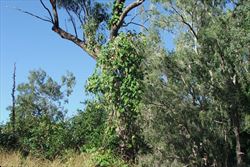
infestation in bushland (Photo: Cook Shire Council)

climbing habit (Photo: Cook Shire Council)
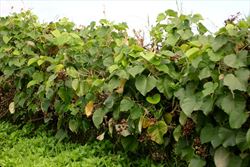
habit growing on a fence (Photo: Forest and Kim Starr, USGS)
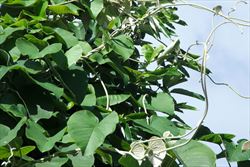
younger stems and leaves (Photo: Cook Shire Council)

large heart-shaped leaves (Photo: Forest and Kim Starr, USGS)
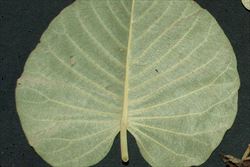
close-up of paler, hairy, leaf underside (Photo: Cook Shire Council)

close-up of hairy stem and young leaf (Photo: Forest and Kim Starr, USGS)
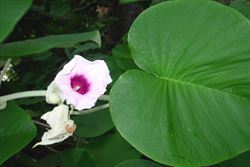
flower (Photo: Chris Gardiner)

close-up of tubular flower with a darker centre (Photo: Cook Shire Council)

clusters of immature fruit (Photo: Cook Shire Council)
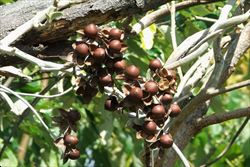
older stems and clusters of mature fruit (Photo: Cook Shire Council)

close-up of mature fruit showing enlarged and persistent sepals (Photo: Cook Shire Council)
Scientific Name
Argyreia nervosa (Burm. f.) Bojer
Synonyms
Argyreia speciosa (L. f.) SweetConvolvulus nervosus Burm. f.Convolvulus speciosus L. f.Rivea nervosa (Burm. f.) Hallier f.
Family
Convolvulaceae
Common Names
baby woodrose, elephant climber, elephant creeper, elephant ear vine, elephant vine, Hawaiian baby woodrose, silver morning glory, wood rose, woodrose, woolly morning glory, woolly morningglory
Origin
Native to India (i.e. from Assam to Belgaum and Mysore) and Myanmar. Elephant creeper (Argyreia nervosa) has sometimes been listed as native to Australia in the past, and this is because there is some doubt as to whether aboriginals may have introduced this species prior to European settlement.
Cultivation
It has been grown as a garden ornamental in the warmer parts of Australia, and is relatively common in home gardens in northern Queensland.
Naturalised Distribution
This species is scattered across a large area of coastal northern and central Queensland. Specimens have been recorded at numerous locations within these regions, including around Townsville (i.e. at Mount Elliot and in the Townsville Town Common), on the Cape York Peninsula, and in the Cooktown, Ingham, Bowen and Calliope areas. It is particularly abundant around the Peter Faust Dam near Bowen.
Elephant creeper (Argyreia nervosa) is also naturalised on some Pacific islands (i.e. Hawaii, New Caledonia, French Polynesia and Tonga), in south-eastern USA (i.e. Florida), in Central America (i.e. Panama, Belize, Nicaragua and Puerto Rico), in the Mascarenes (i.e. La Réunion) and in tropical Africa (i.e. Ghana).
Habitat
This species is a weed of tropical and sub-tropical habitats, including rainforests, open woodlands, roadsides, distrubed sites and waste areas.
Habit
A robust climber that grow up to a height of 10 m or more and can cover trees.
Distinguishing Features
- a robust woody climber with densely hairy younger stems.
- its large leaves are heart-shaped with whitish-silver hairy undersides.
- its large tubular flowers (about 5 cm across) are usually pink with darker pink or purple centres.
- its fruit is a dry brown capsule (about 2 cm across) surrounded by five enlarged and persistent sepals.
Stems and Leaves
Its stems are relatively thick and become woody with age. The younger stems are densely covered in whitish coloured hairs.
The large leaves (15-30 cm long and 13-30 cm wide) are heart-shaped (i.e. ovate-cordate) with pointed tips (i.e. acute apices). They have hairless (i.e. glabrous) upper surfaces and persistently silvery-white hairy (i.e. tomentose) undersides. These leaves are alternately arranged along the stems and are borne on long stalks (i.e. petioles).
Flowers and Fruit
The large tubular flowers (5-7.5 cm long and about 5 cm across) are borne in clusters on long stalks (up to 15 cm long) that are covered in white hairs (i.e. on tomentose peduncles). They have five sepals (13-20 mm long when in flower) that are velvety-hairy like the undersides of the leaves. The petals are fused together into a tube (i.e. corolla tube) that varies in colour from pale pinkish to white with a much darker throat that is dark pink to violet. Flowering occurs mainly during spring and summer.
The fruit is a rounded (i.e. globose) leathery berry (1-2 cm across) that does not split open when mature (i.e. it is indehiscent). It is surrounded by the five persistent sepals and this structure has been likened to a carved rose (hence the Hawaiian common name of 'woodrose'). Each of these fruit contains 4-6 large seeds that are light or dark brown in colour.
Reproduction and Dispersal
This species reproduces mainly by seed, but it is also known to reproduce by vegetative fragmentation.
It seeds have been widely transported across the world for use as a garden ornamental and as a source of hallucinogenic drugs, and therefore seeds and plant parts may be spread in dumped garden waste. However, seeds are mainly thought to be dispersed into natural areas by fruit-eating (i.e. frugivorous) birds and other animals. Seeds and plant parts may also be dispersed in floodwaters.
Environmental Impact
Elephant creeper (Argyreia nervosa) is regarded as an environmental weed in northern Queensland and is included on the Cape York Peninsula priority weed list. It is an aggressive invader of rainforest and other tropical forest communities in northern Queensland and has been observed to smother trees, much like rubber vine (Cryptostegia grandiflora). Anecdotal reports from Queensland National Parks and Wildlife staff suggests that it can germinate quite readily in seemingly undisturbed sites, and it is capable of growing under rainforest canopies and among dense grass cover in eucalypt woodlands.
It thrives around Townsville, which has a comparatively low rainfall and is in a dry monsoonal area, and is also aggressive around Cooktown, where the summer rainfall is very high. Hence, elephant creeper (Argyreia nervosa) is seen as a potential threat to conservation areas in both the wet tropics and dry tropics regions.
Legislation
Not declared or considered noxious by any state government authorities.
Similar Species
Elephant creeper (Argyreia nervosa) is similar to several of the morning glories (i.e. Ipomoea spp.), including bush morning glory (Ipomoea carnea subsp. fistulosa), the native palmate-leaved morning glory (Ipomoea mauritiana), coastal morning glory (Ipomoea cairica), the native water spinach (Ipomoea aquatica) and sweet potato (Ipomoea batatas). These species all have large pale pinkish or purplish flowers with darker centres, however they can be distinguished by the following differences:
- elephant creeper (Argyreia nervosa) is a robust climbing plant with very large heart-shaped (i.e. cordate) leaves. Its younger stems and leaf undersides are densely covered in whitish hairs (i.e. tomentose).
- bush morning glory (Ipomoea carnea subsp. fistulosa) is an upright shrubby plant with large narrow or broad leaves that may sometimes have heart-shaped (i.e. cordate) bases. Its younger stems and leaf undersides are somewhat hairy (i.e. pubescent).
- palmate-leaved morning glory (Ipomoea mauritiana) is a climbing plant with leaves that are deeply but not completely divided into several spreading lobes like the fingers of a hand (i.e. palmatifid). Its younger stems and leaf undersides are mostly hairless (i.e. glabrous).
- coastal morning glory (Ipomoea cairica) is a climbing plant with leaves that are divided almost to the base into several spreading lobes like the fingers of a hand (i.e. palmatisect). Its younger stems and leaf undersides are mostly hairless (i.e. glabrous).
- water spinach (Ipomoea aquatica) is creeping or aquatic plant with leaves that can vary from long an narrow (i.e. lanceolate) to heart-shaped (i.e. cordate) with entire or slightly lobed (i.e. sinuate) margins. Its younger stems and leaf undersides are mostly hairless (i.e. glabrous).
- sweet potato (Ipomoea batatas) is creeping plant with leaves that can vary from entire and heart-shaped (i.e. cordate) to deeply but not completely divided into several spreading lobes like the fingers of a hand (i.e. palmatifid). Its younger stems and leaf undersides are mostly hairless (i.e. glabrous).
Elephant creeper (Argyreia nervosa) can also be distinguished from all of the morning glories (i.e. Ipomoea spp.) buy its fruit, which are leathery berries that do not split open when mature.

